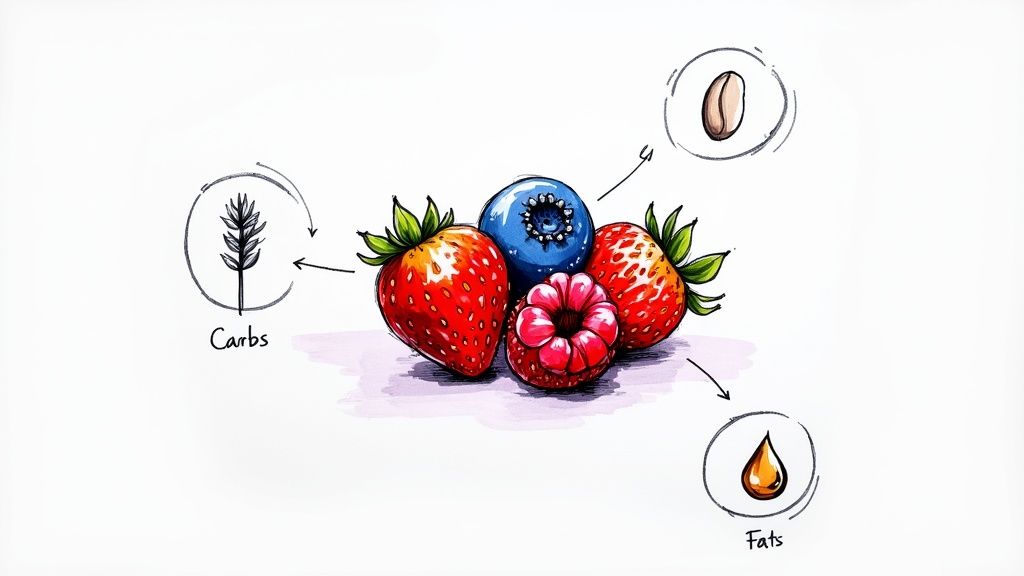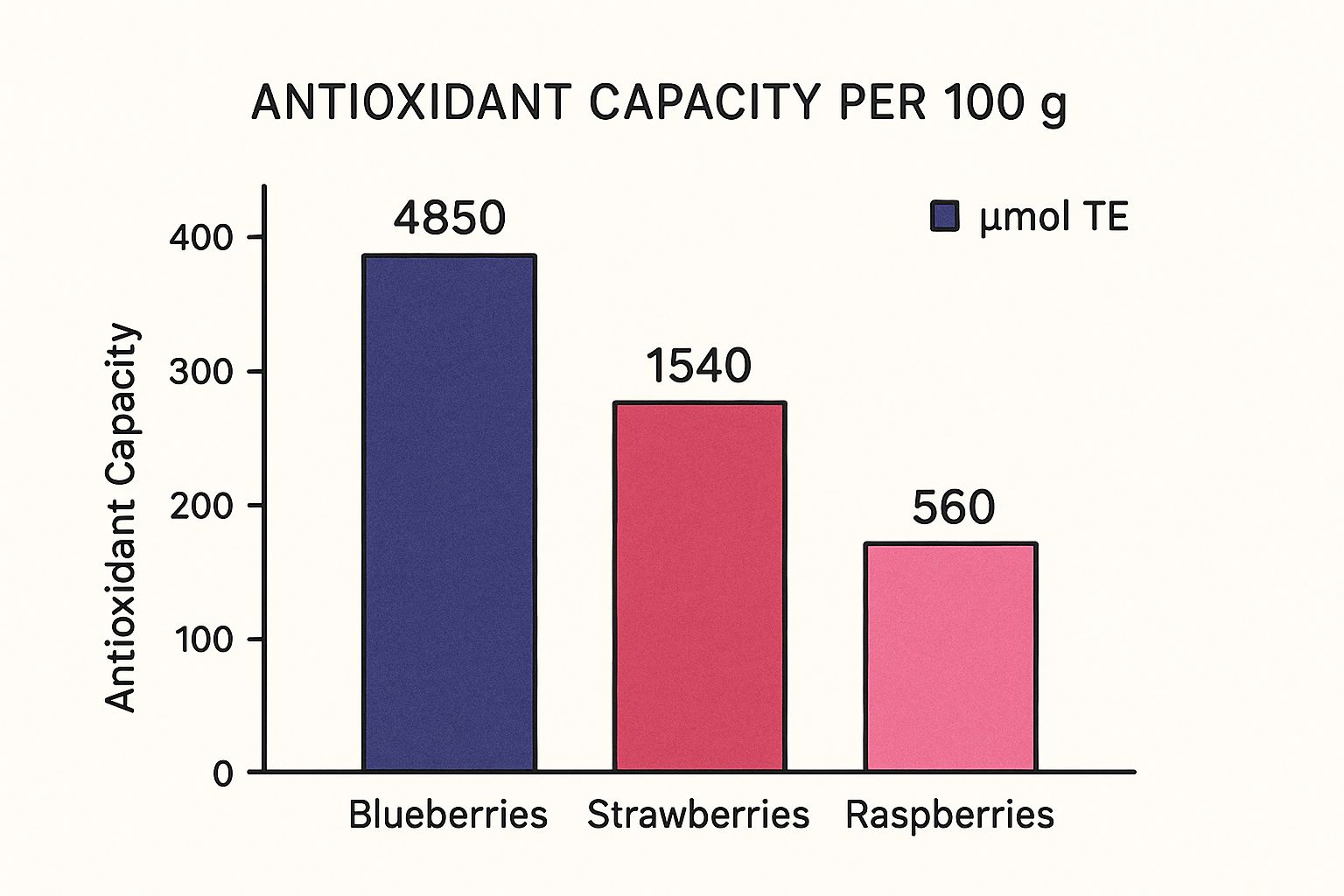A Simple Guide to Mixed Berries Nutrition Facts
Explore mixed berries nutrition facts in our simple guide. Learn about calories, macros, vitamins, and the health benefits of your favorite berry mix.
Posted by
When you grab a handful of mixed berries, you're getting more than just a sweet treat. They're a powerhouse of nutrition packed into a low-calorie snack, making them an awesome addition to any eating plan.
A standard cup of mixed berries comes in at around 117 calories. What's even better is that they have virtually no fat and are loaded with fiber, which is fantastic for keeping you full and supporting healthy digestion.
A Quick Look at Mixed Berries Nutrition
Ever wondered what's really inside that colorful bowl of berries? Let's break it down. Understanding the basic nutrition facts shows you just why they're such a smart choice for breakfast, a snack, or even dessert.
Thinking about nutrition isn't about obsessively counting every single gram. It's more about being mindful of what you're putting into your body. Berries are a perfect example of this—they're naturally low in things you might want to limit (like fat) and high in the good stuff, making them an easy win.
What’s in a Cup
So, what does a typical one-cup serving (about 233 grams) of fresh mixed berries give you? You're looking at 117 calories, a minimal 0.8 grams of fat, and 28.3 grams of carbohydrates. Most importantly, it delivers a hefty 6.7 grams of fiber.
Because they contain zero cholesterol and sodium, mixed berries are a fantastic heart-healthy food. For a more detailed breakdown of how different berry types compare, Snap Calorie offers some great insights.
Here’s a simple table to give you a clear picture at a glance.
Mixed Berries Nutrition Facts Per Cup
This table summarizes the key nutritional information for a one-cup (233g) serving of fresh mixed berries.
| Nutrient | Amount | Daily Value (DV) |
|---|---|---|
| Calories | 117 kcal | 6% |
| Total Fat | 0.8 g | 1% |
| Sodium | 0 mg | 0% |
| Total Carbohydrate | 28.3 g | 10% |
| Dietary Fiber | 6.7 g | 24% |
| Sugar | 18.2 g | N/A |
| Protein | 1.8 g | 4% |
As you can see, you get a significant amount of your daily fiber needs from just one serving, which is great for digestive health and feeling satisfied.
Tracking this is incredibly easy with an app like munchlog.ai. You can just say, "I had a cup of mixed berries with my yogurt," and the app does the heavy lifting for you. Curious how this stacks up against other fruit medleys? Check out our complete guide on the calories in a fruit bowl.
Understanding The Macros In Mixed Berries

When you start looking at nutrition, “macros” just means carbohydrates, protein, and fat. Mixed berries are mostly carbs—but these are the good kind, far from the refined sugars you'd find in soda or candy.
Their real strength is the fiber they bring to the table. Fiber slows down digestion, helps keep your blood sugar steady, and makes you feel full long after you’ve finished snacking.
Carbs, Protein, And Fat Breakdown
Here’s a quick reference for a 1-cup serving of mixed berries:
| Macro | Amount Per Cup | Notes |
|---|---|---|
| Carbohydrates | 28 g | Includes 7 g of fiber for sustained energy |
| Protein | < 2 g | Best complemented with a higher-protein food |
| Fat | < 1 g | Combine with nuts or seeds to boost healthy fats |
This lean profile makes berries an ideal, low-calorie addition to almost any meal. They add sweetness, texture, and volume without weighing you down. For a deeper dive into how these carbs fuel your body, check out our guide on complex carbohydrate examples.
Practical Examples
- Mix berries into Greek yogurt for a simple protein boost.
- Sprinkle sliced almonds or walnuts on top to add some healthy fats.
- Blend them with spinach and protein powder for a well-rounded smoothie.
Quick tip: Just saying “bowl of yogurt with mixed berries and almonds” into Munchlog.AI instantly breaks down your snack into clear macro numbers—no math required on your end.
A Closer Look at Strawberries and Blueberries
Berries are nutritional powerhouses, packed with essential vitamins and minerals that go way beyond basic macros. To really get why they're so great, let's look at two favorites you'll find in any mix: strawberries and blueberries. Each brings something unique to the table, and when you combine them, you get a much broader range of nutrients.
Strawberries are probably most famous for their incredible Vitamin C content. It's a vital antioxidant that plays a big role in keeping your immune system running strong. To put it in perspective, a single 150-gram serving of strawberries can deliver about 150% of your daily recommended Vitamin C. You can learn more about why berries are so beneficial from this in-depth Healthline article.
Why a Mix Is Better Than a Single Berry
While strawberries are the star when it comes to Vitamin C, blueberries shine in other areas. They are a fantastic source of manganese and Vitamin K, both of which are crucial for bone health. This is exactly why a varied handful of berries is so much better for you. If you only eat one type, you're missing out on the unique benefits the others provide.
Eating a variety ensures you get a wider array of micronutrients. Think of it this way:
- Strawberries: Your go-to for a major immune boost.
- Blueberries: A key player for bone health and other antioxidants.
This approach isn’t just smarter nutritionally; it also keeps your meals more interesting and delicious.
When you start casually logging your food, you begin to see these nutritional details pop up. You might realize you’re crushing your Vitamin C goals with strawberries but could use more of the nutrients found in blueberries. It's not about being perfect, but about making small, smarter choices over time.
By logging "a handful of strawberries and blueberries" in a tool like munchlog.ai, you get a much clearer picture of what you're eating. It takes you past simple calorie counting and shows you all the incredible micronutrients you're feeding your body. Seeing this makes healthy eating feel less like a chore and more like you're doing something good for yourself.
Nutritional Highlights Of Blackberries And Raspberries
Blackberries and raspberries aren’t just colorful – they’re a smart choice for anyone looking to boost their fiber and micronutrient intake. Both deliver a lot of nutritional bang for their calorie buck.
Why These Berries Matter
- Low In Calories: Blackberries have 43 kcal per 100g, while raspberries offer 52 kcal.
- High In Fiber: With 5g (blackberries) and 7g (raspberries), they support healthy digestion and help you feel full longer.
- Key Micronutrients: Blackberries are a good source of Vitamin K and manganese, while raspberries really shine with their Vitamin C content.
For more on berry benefits, see the Healthline comprehensive berry guide.
Blackberries Vs Raspberries Nutrition Per 100g
Use this table when you need a quick comparison. It’s perfect for meal planning or just being curious about your macros.
| Nutrient | Blackberries | Raspberries |
|---|---|---|
| Calories | 43 kcal | 52 kcal |
| Carbohydrates | 10 g | 12 g |
| Dietary Fiber | 5 g | 7 g |
| Sugar | 5 g | 4 g |
| Protein | 1 g | 1 g |
| Vitamin C | 35% DV | 44% DV |
| Vitamin K | 25% DV | 7% DV |
Pairing raspberries and blackberries gives you the best of both worlds: extra fiber from raspberries and a nice dose of Vitamin K from blackberries.

This visual is a great reminder of the unique goodness in each berry. Logging “a handful of raspberries and blackberries” into munchlog.ai makes it easy to track these subtle nutritional differences in your daily diet without any extra effort.
Why Antioxidants in Berries Are So Important
You’ve probably heard the term “antioxidants” thrown around, but what do they actually do? Think of them as your body's personal defense squad. They help protect your cells from the daily wear and tear caused by unstable molecules called free radicals.
This cellular stress is a normal part of life, but over time it can contribute to aging and various health issues. That's where antioxidants step in to help keep things in balance.
Berries are famous for being packed with these protective compounds. Those deep, vibrant reds, blues, and purples aren't just for show; they're a clear sign of powerful plant compounds called anthocyanins. These are some of the most effective antioxidants you can find in food, and they're a major reason why mixed berries are so good for you.
Looking Beyond the Numbers
While calories and macros give you part of the picture, the real value of a food often lies in its quality. The natural compounds in mixed berries, like those anthocyanins, are a perfect example. For instance, research consistently shows that blackberries have an incredibly high concentration of antioxidants, making them a fantastic choice for fighting off cellular stress. You can dive deeper into the science behind these berry compound findings.
Eating a mix of different berries is a great strategy because each type offers a slightly different profile of these beneficial compounds.
Thinking about the antioxidant power of your food can really shift your mindset. It helps you see that a handful of berries is so much more than its calorie count—it's a boost for your long-term well-being.
So when you log “a scoop of mixed berries in my oatmeal” with munchlog.ai, remember you’re not just counting carbs. You're acknowledging a choice that’s full of cell-protecting goodness, which makes sticking to healthy habits feel that much more meaningful. It’s an easy way to connect the dots between what you eat and how great you feel.
Easy Ways to Track Your Berry Intake

Knowing the nutrition facts for mixed berries is a great first step, but keeping track of what you eat shouldn't feel like a full-time job. Thankfully, it doesn't have to be. You don't need a food scale or measuring cups to be more mindful of your diet.
The idea behind casual tracking is to make it fit into your life. Whether you're tossing berries into a smoothie or just grabbing a handful for a snack, simply noting your choices helps build healthier habits over time, minus the stress of perfect measurements.
Log Your Berries Just by Talking
Voice logging is probably the easiest way to keep a food diary. Instead of manually typing in every detail, you just say what you ate in plain English. It's a simple change, but it removes the friction that often makes people give up on tracking.
Here are a few real-world examples of how you could log your berries with a tool like munchlog.ai:
- "I had a handful of mixed berries with my yogurt this morning."
- "Added about half a cup of frozen berries to my protein smoothie."
- "Snacked on a small bowl of strawberries and blueberries."
The AI is smart enough to understand these natural phrases and turn them into useful nutritional data. This is a huge step up from many of the best nutrition tracking apps that require you to be much more precise.
Just by talking about your meals, you'll start to notice patterns. You might realize you’re getting a solid dose of fiber every breakfast, or that your go-to afternoon snack is packed with antioxidants.
This low-effort method helps you stay aware of your diet without getting bogged down in numbers. It’s all about making small, sustainable changes that help tracking feel like a natural part of your routine.
Your Questions About Berry Nutrition, Answered
When you're trying to eat better, you're bound to have a few questions. Let's clear up some of the most common ones about mixed berries so you can feel confident about adding them to your plate.
A little bit of knowledge goes a long way in showing why a simple handful of berries is one of the best snacks you can reach for.
Are Frozen Berries As Good As Fresh?
They sure are. In fact, sometimes they’re even better. Frozen berries are picked at their peak ripeness and then flash-frozen, a process that does an amazing job of locking in their nutrients.
Fresh berries might have spent days traveling to your local store, losing some nutritional value along the way. Frozen berries, on the other hand, have their vitamins and antioxidants preserved almost immediately. So go ahead and pile them into your smoothies and oatmeal—they’re a convenient, affordable, and incredibly healthy choice.
How Many Carbs Are Really In a Cup of Berries?
A standard cup of mixed berries (about 150g) usually has around 20-25 grams of total carbohydrates. But here’s the key part: a big chunk of that, typically about 8 grams, is dietary fiber.
That high fiber count is a game-changer. It not only supports your digestive system but also means the "net carbs" are much lower, making berries a great option even if you're keeping an eye on your carb intake.
Will Berries Spike My Blood Sugar?
For most people, no. Berries are one of the best fruits you can eat for stable blood sugar. Their high fiber content slows down how quickly their natural sugars enter your bloodstream.
This means you get a steady stream of energy without the dramatic spike and crash you’d get from a sugary treat or even some other fruits. They’re a genuinely satisfying snack that won't leave you feeling sluggish later.
What's the Easiest Way to Track a Handful of Berries?
The simplest way is to just talk like you normally would. Forget weighing scales and precise measurements. With an app like munchlog.ai, you can use your voice and natural language to log what you ate.
You could say something like, "I had a small bowl of mixed berries," or "I put a handful of strawberries and blueberries in my smoothie." The AI is designed to understand these real-world portions, making the whole process quick, intuitive, and stress-free.
Ready to stop guessing and start tracking your nutrition the easy way? Try munchlog.ai and see how simple it is to log your meals with just your voice. Get started at https://munchlog.ai.